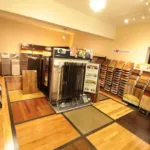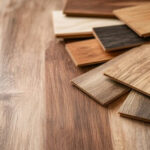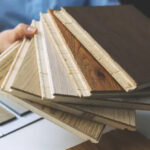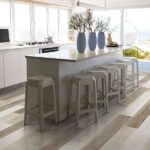Floors can add a stunning, polished look to any home. However, it’s important to establish a regular cleaning routine in order to maintain their beauty and functionality over the years. Neglecting to properly care for your floors can lead to wear and tear, diminishing their appeal and overall performance. To ensure that your floors remain the centerpiece of your home, it’s essential to follow a consistent cleaning process – especially in Boise where we can have snow salts, mud, dirt and other things.
Why Floor Finishes Break Down
It’s important to remember that dirt is a major enemy of floors. Even the most carefully applied floor finishes can’t fully protect against the abrasive effects of dirt, which can slowly wear away at the surface of your floors over time. To keep your floors looking their best and to preserve their finish, it’s essential to keep them as free of dirt as possible. This means regularly sweeping, vacuuming, and mopping to remove dirt and grime, and being mindful about tracking in dirt from the outdoors. By keeping your floors clean and free of dirt, you can extend their lifespan and ensure that they remain a beautiful and functional part of your home.
It’s interesting to hear about how even the toughest floor finishes can be compromised by the abrasive effects of dirt. It’s a good reminder of the importance of keeping our floors clean, especially in environments where there may be more dirt or grit present, such as beach houses or other homes in high-traffic areas. Regular cleaning and maintenance can help to protect the finish of your floors and keep them looking beautiful for years to come.
Yes, the moral of the story is that keeping dirt off your floors is key to maintaining their beauty and preserving their finish. It’s important to regularly sweep, vacuum, and mop your floors to remove dirt and grime, and to be mindful about tracking in dirt from the outdoors. By following a consistent cleaning routine and being vigilant about keeping your floors clean, you can help to ensure that they remain a beautiful and functional part of your home for years to come.
Why Use Products To Prevent Flooring Damage
It’s definitely true that furniture can be a source of damage to floors, especially if it’s not properly protected or placed on the floor. To help prevent damage from furniture, you can use floor protectors or pads on the feet of your furniture. These products are designed to help distribute the weight of your furniture more evenly and to prevent scratches or dents on your floors. You can also use rugs or mats in high-traffic areas or under heavy furniture to help protect your floors from wear and tear. Additionally, it’s a good idea to rearrange your furniture occasionally to avoid the development of permanent indentations or scratches in your floors.
Simple Way to Prevent Dirt in Your Home & on Your Floors
Here are a few more ways to prevent dirt from getting into your house:
- Encourage everyone in your household to remove their shoes when entering the house
- Keep a shoe rack or designated area for shoes near the entrance to your home
- Use doormats both inside and outside your front door to help catch dirt and grime
- Wipe your feet or use a boot tray by the door to remove excess dirt and moisture
- Consider using door mats made of materials that are specifically designed to remove dirt and debris from shoes, such as coir or rubber
- Regularly sweep, vacuum, and mop your floors to remove any dirt or grime that may have been brought into the house
- Use area rugs or runners in high-traffic areas to help protect your floors and make them easier to clean
How to Stop Furniture from Damaging Floors
To protect your floors from damage caused by furniture, you can use floor protectors or pads on the feet of your pieces to distribute weight evenly and prevent scratches and dents. Avoid leaving heavy furniture in one spot for an extended period of time to prevent indentations, and be sure to carefully lift and place furniture rather than dragging it across the floor. You can also use rugs or mats under heavy furniture to add an extra layer of protection, or consider using furniture sliders or gliders to make it easier to move your pieces without damaging your floors. Additionally, rearranging your furniture regularly can help to avoid the development of permanent scratches or indentations. By following these simple steps, you can keep your floors looking perfect.
- Use pads under your furniture, especially chairs, which should be changed out every six months. Felt pads work well and can help to preserve your floors.
- Avoid sliding furniture, as this can put a lot of pressure on the and potentially damage the finish. Instead, lift and carry your furniture to prevent dents and scratches.
- To protect your floors from damage caused by your refrigerator, invest in plastic fridge runners. These will help to distribute the weight of your fridge and prevent the wheels from damaging your floors.
- Avoid moving your refrigerator too frequently, as the weight and small wheels can create a lot of pressure on your floors. By following these tips, you can help to keep your floors in perfect condition.
Overview of Cleaning Products For Floors
Walk into a store in Boise, Idaho and count how many products there are for floors. There are cleaners, rejuvenators, and other products that claim to help maintain the appearance and condition of floors. However, it’s important to be cautious when selecting products to use on your floors, as some can actually cause more harm than good. Using the wrong products can add films, acrylics, and other substances to your floor that can break down over time and make your floor look unattractive or require frequent reapplication to maintain its appearance. In the following text, we will discuss some products that may not be ideal for your floors and some that are proven to be effective.
What Floor Cleaning Products to Use For Floor Cleaning
At our store and online, you can find a range of products that are suitable for nearly all types of flooring, including LVP and LVT. These products use a pH level of 7 to effectively clean your floors without altering their shine. In fact, they are specifically designed to simply aid in the cleaning process without leaving behind any residue or requiring frequent reapplication. Maintaining the cleanliness of your floors is important, and using the right products is key to achieving this without causing any damage or wear to the flooring.
Good wet cleaner products we have found over the years:
Good dry cleaning products:
- Microfiber towel / mop
- Swiffer dry (dry only not wet)
These cleaners are described as being specifically designed to remove dirt and grime from the surface of the floor without altering its appearance or requiring frequent reapplication. These products are available in your store and are suitable for use on a variety of flooring types.
What Floor Cleaning Products to NOT Use For Floor Cleaning
There are many products on the market in Boise that claim to be suitable for cleaning floors, but in reality, they can actually cause damage to your flooring. These cleaners and rejuvenators may initially make your floor look good for a short period of time, but over time they can cause the floor to dull, become excessively shiny, or even flake or peel off. The problem with these products is that they do not bond properly with the finish on your floor.
Products to avoid for cleaning floors:
- Bona polish – This product has a tendency to peel or ruin your floor. While Bona offers other high-quality flooring products, this particular product is not recommended.
- Murphy’s Oil Soap – This product contains acrylics that leave a film on the floor that will eventually peel off.
- Vinegar and water – The acidity in vinegar can cause the finish on your floor to age more quickly over time. It is better to use a pH-neutral cleaner.
- Orange Glow – This product is an acrylic that dries hard and attracts dirt and dust, which can cause it to flake off. It also has an orange color that may not be desirable.
- Steam mops – Using steam to clean your floor can be more harmful than using water. The steam can penetrate the coating on your floor, and once it cools down, it cannot escape, leading to rot. It is best to avoid using steam mops when cleaning floors.
How To Clean/Sweep/Mop Floors
Maintaining the cleanliness and appearance of floors can be straightforward, but to achieve the best results on a consistent basis, it’s important to use the proper methods. I have personally tested and refined various techniques over the past 10 years in Boise, and have received positive feedback from my past customers about their effectiveness. If you’re looking for the most effective way to clean your floors, I recommend using the methods that I have found to be the most successful.
Best Method for Cleaning Floors
We know that dust, dirt, and grime can cause damage to floors over time by abrading the surface. To prevent this, it’s important to use furniture pads to lift and move furniture rather than sliding it across the floor. Now, the question is how to effectively remove dirt from your floors without damaging the finish. Here is a step-by-step guide for cleaning your floors:
- Prepare the floor for cleaning – First, remove any large debris such as toys or extra furniture that may be in the way. This will allow you to clean the entire floor without missing any areas or trying to navigate around obstructions.
- Vacuum the floor – Use a vacuum specifically designed for floors, with soft bristles around the head to avoid scratching or damaging the finish.
- Remove any remaining dirt or sticky grime – It may be necessary to use a separate method to remove particularly stubborn dirt or grime from the floor. We will discuss this in more detail below.
- Dry tack – Use a microfiber or Swiffer dry pad to pick up any remaining dust, hair, or fur on the floor. This is an important step to ensure the floor is fully prepared for wet cleaning.
- Wet tack/wet mop – Use a damp pad (microfiber with a cleaning solution) to wipe the floor in a “S” pattern, starting at the edge of the room and making turns at the end of each pass. Be careful not to use too much cleaning solution, as you don’t want to flood the floor. The goal is to clean the , not create a muddy mess.
It’s important to be mindful of the amount of water used when cleaning floors. Excessive moisture can raise the moisture content of the , potentially leading to problems such as cupping or finish damage. To avoid these issues, use only a small amount of cleaning solution and be sure to thoroughly dry the floor after cleaning.
Long Term Maintenance of Floors – Overview
Maintaining the long-term health and appearance of floors involves more than just regular cleaning. Every day in Boise, the finish on your floor can become worn or damaged. To prevent the need for frequent sanding and refinishing, it’s important to implement a comprehensive maintenance plan. This should include deep cleaning, as well as screen and coat treatments to keep the floors in top condition. By following these recommendations, you can help ensure your floors remain beautiful for years to come.
Deep Cleaning Flooring
Deep cleaning is a good option for homes with heavy foot traffic or for commercial spaces like shops and restaurants. This method is more thorough and removes oils, dirt, and hard-to-remove grime from the pores of the . It is not necessary to deep clean your floors on a daily basis, but it can be helpful to do so once a year for high traffic homes or once every quarter for commercial spaces. The deep cleaning process uses a more abrasive cleaner and specialized equipment with soft bristles that do not damage the finish. The combination of the abrasive cleaner and the gentle bristles is more effective than traditional cleaning methods. One of the benefits of deep cleaning is that the water is immediately vacuumed up, preventing the from coming into contact with excess moisture.
Buff and Coat | Screen and Coat Floors
If you properly maintain your floors, they should only need a buff and coat or screen and coat treatment every 5-7 years. This is necessary when the existing finish begins to wear down and becomes thin, requiring a refresh with new finish. A flooring professional (not a carpet specialist) can typically complete this process in half a day. Once the screen and coat treatment is finished, the floor should look almost brand new again, with its original shine restored. Here is a brief overview of the screen and coat process:
- clean the floor
- vacuum the floor
- buff the floor with sandpaper
- clean the floor with an adhesion booster
- vacuum the floor
- tack the floor
- put new finish on
By following the above information and buffing and coating your floors, you will never truly need to refinish your floors again.
Author Profile
- I have worked in hardwood flooring for the last 8 years. Use to run a company of residential crews as well as a company with gym flooring. If you need floor installation or refinishing help, I should have an answer or at least get you in the right direction.
Latest entries
 FlooringDecember 24, 2025Right Advice For Picking The Ideal Hardwood Flooring Options
FlooringDecember 24, 2025Right Advice For Picking The Ideal Hardwood Flooring Options FlooringDecember 22, 2025What is Your Favorite Type of Hardwood Flooring and Why?
FlooringDecember 22, 2025What is Your Favorite Type of Hardwood Flooring and Why? FlooringDecember 15, 2025What is the Most Durable Engineered Hardwood Flooring?
FlooringDecember 15, 2025What is the Most Durable Engineered Hardwood Flooring? FlooringDecember 12, 2025How Do You Maintain Vinyl Flooring in Spokane Homes?
FlooringDecember 12, 2025How Do You Maintain Vinyl Flooring in Spokane Homes?

